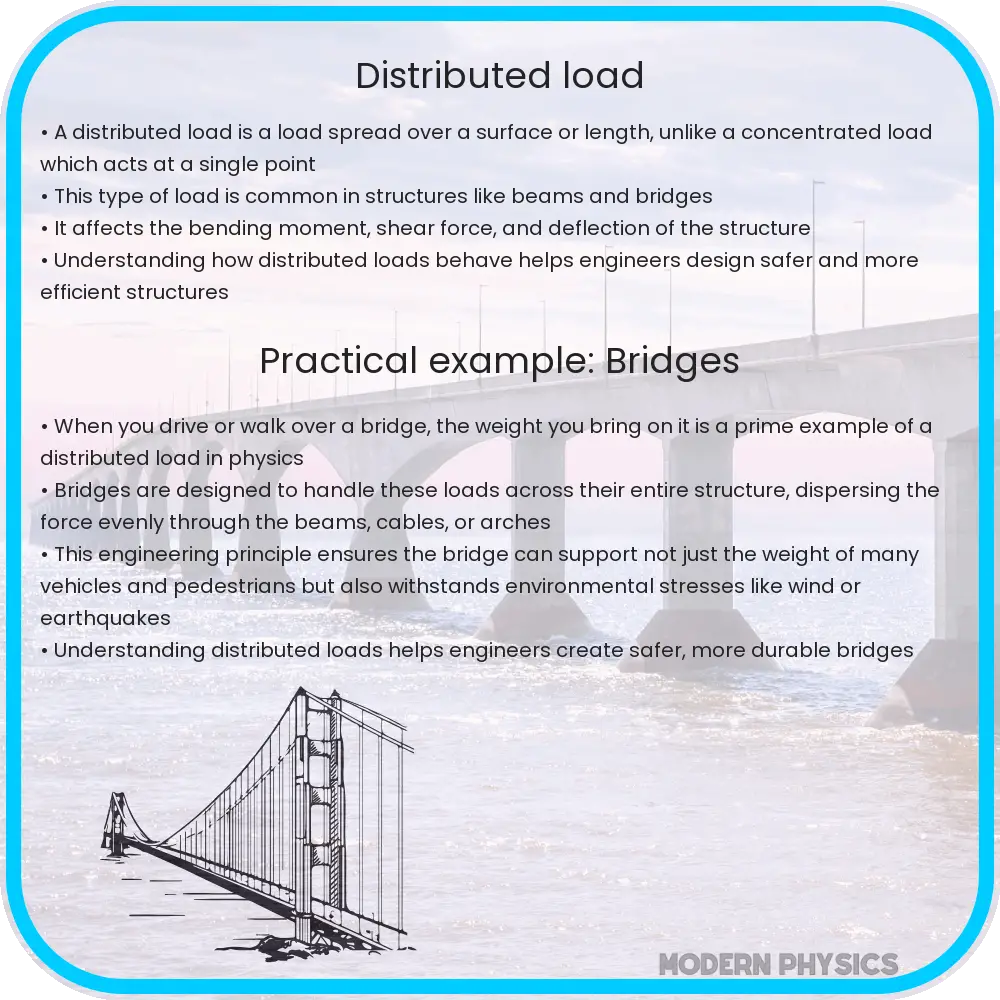Explore the fundamentals of distributed load in statics, including its calculation, applications, and advanced analysis techniques for engineering.

Understanding Distributed Load in Statics
Distributed load is a fundamental concept in the field of statics, which is a branch of mechanics dealing with bodies at rest under balanced forces. Unlike point loads that act at a single point, distributed loads are spread over an area or a length, exerting a continuous force per unit area or length.
Basics of Distributed Load
Distributed loads are typically represented in two forms:
- Uniformly Distributed Load (UDL): This type of load has a constant magnitude per unit length or area. It is often represented in diagrams as a series of arrows showing equal intensity.
- Non-uniformly Distributed Load: In this case, the magnitude of the load varies along its length or area. It’s often represented by a loaded beam with arrows that vary in size.
Calculation of Distributed Load
The calculation of distributed load involves determining the resultant force and its point of application. For a UDL, the resultant force (F) is calculated as:
F = w × l
where w is the load per unit length and l is the length over which the load is distributed. The point of application of this resultant force is at the centroid of the distributed area.
In the case of non-uniformly distributed loads, the calculation becomes more complex, often requiring integration to find the resultant force and its point of application.
Application in Statics
Distributed loads are common in engineering and architectural designs. Some typical applications include:
- Structural Beams: Beams in buildings and bridges often carry distributed loads due to their own weight and the weight of the structures or materials they support.
- Pressure on Walls: The pressure exerted by liquids or gases on container walls or dams is another example of a distributed load.
- Aerodynamic Forces: The forces exerted by air or water flow over the surfaces of aircraft and ships are distributed loads.
Distributed loads are critical in determining the strength and stability of structures. Engineers use these calculations to ensure that structures can withstand the forces they are subjected to in their intended use.
Advanced Considerations in Distributed Load Analysis
In addition to the basic calculations, advanced scenarios in statics may require more complex analysis of distributed loads. For instance, when dealing with curved structures or varying cross-sectional areas, the load distribution may not be straightforward. In such cases, calculus and numerical methods are employed to accurately model and analyze the load distribution.
Practical Examples and Case Studies
Real-world examples provide valuable insights into the application of distributed load principles. For instance, in bridge design, distributed load analysis helps in understanding how vehicles and pedestrians exert force over the structure. Similarly, in the design of roofing systems, distributed loads due to snowfall or wind pressure are crucial factors.
Software and Tools in Distributed Load Analysis
Today, engineers rely heavily on computational tools and software for distributed load analysis. Software like ANSYS, AutoCAD, and SAP2000 provide sophisticated means to simulate and analyze distributed loads, allowing for more precise and efficient design processes.
Teaching and Learning Distributed Load Concepts
For students and practitioners in engineering, understanding distributed loads is essential. Educational institutions often incorporate practical experiments, simulations, and project-based learning to impart these concepts effectively.
Conclusion
Distributed load analysis is a cornerstone in the field of statics, playing a pivotal role in the design and analysis of various structures. From simple beams to complex architectural marvels, understanding how distributed loads work is crucial for safety and efficiency. As technology advances, the methods and tools used in this analysis continue to evolve, offering more precision and reliability. For engineers, architects, and students, mastering the concepts of distributed load remains a fundamental and ongoing endeavor, ensuring that the structures they design are both functional and resilient under the diverse forces they encounter in real-world scenarios.
